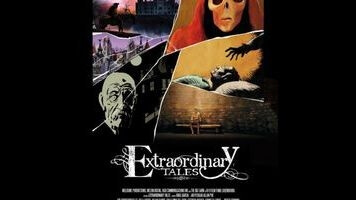
You never know what you’re getting in an animation anthology—they tend to be grab bags of visually and even thematically unrelated material, varying widely in quality. Extraordinary Tales initially seems like it should be an exception to the rule: It’s a themed anthology of five Edgar Allan Poe short-story adaptations, all helmed by the same man. But Spanish-born director Raul Garcia seems to have gone out of his way to preserve the diverse anthology feel. Each of the shorts has a markedly different visual approach, and they feel radically distinct in terms of pacing and editing as well. In spite of the common source material and tone of oppressive psychological horror, these shorts feel like they could be the work of five different people.
Garcia, who’s worked in cel animation since the 1980s, and had a hand in most of the big Disney features of the 1990s, worked entirely in CG for this collection, and the one commonality between the shorts is an old-school computerized liquidness in the character design. Whether the characters look rotoscoped or assembled from polygons, they all move like their joints are well-oiled and their bodies are made of loosely associated planes, which gives the feature an extra dose of uncanny-valley eeriness. But the designs run a wide gamut from short to short. “The Tell-Tale Heart,” as read by Bela Lugosi in a vintage recording, is animated in stark black and white, imitating the comic-book work of Alberto Breccia. (Frank Miller’s Sin City books and Daniel Clowes’ graphic novels come to mind as well, as does the Charles Burns short in the French anthology Fear(s) Of The Dark.) And it couldn’t be more different from the lush, colorful take on “The Fall Of The House Of Usher,” narrated by Christopher Lee in his final film role, and painted in an overripe, near-neon style to evoke Expressionist art.
The other three shorts are equally dissimilar visually. “The Mask Of The Red Death” is the collection’s least-satisfying entry; visually inspired by Egon Schiele’s gaunt, twisted, muscular portraits and Pieter Bruegel’s stark color contrasts, it comes virtually without intelligible dialogue. (Roger Corman is credited as narrator, but he barely speaks.) It’s mostly a slow-panning impressionistic blur of debauchery followed by death, impossible to follow for anyone who isn’t already familiar with the story. “The Pit And The Pendulum,” breathlessly narrated by Guillermo Del Toro and presented in a stylized photorealism, is by contrast all narration and darkness, and is chillingly intense even though it feels like an illustrated voice-over. But the most striking of the shorts—both because it’s less familiar as a Poe standard and because the garish EC Comics colors and extreme angles heighten its intensity—is “The Facts In The Case Of M. Valdemar.” Julian Sands narrates this story about a man hypnotized at the point of death, and while the content of the story is almost hilarious in its junk-science belief in the occult powers of mesmerism, the results are strikingly grotesque, exactly like the comics Garcia is paying homage to.
But more charming than any of these pieces is the connecting tissue Garcia weaves around them, featuring Poe, reincarnated as a raven (and voiced by Stephen Hughes) exploring a melancholy autumn graveyard and conversing with an avatar of Death (Cornelia Funke) about his legacy. The lead-ins to the stories get a little attenuated, as Poe or Death remind each other about Poe’s favorite themes, but fail to make a cogent argument as to why they’re telling each other these particular stories. Still, the frame story has a delicate, mournful aesthetic that’s unusual in animation. And it works perfectly to soothe viewers between emphatic moments of crazed Poe shouting. After “It is the beating of his hideous heart!” everyone can use a little emotional downtime and reset.
Extraordinary Tales feels more like a showreel highlighting Garcia’s stylistic diversity than like a single coherent project, and some of the bits he trims from Poe are particularly regrettable. And for longtime Poe readers, there aren’t enough surprises in this familiar work. But for newcomers and animation fans, this showcase is a strong one, running the gamut of emotion from softly sorrowful to histrionic, and capably bringing out the bone-deep horror of Poe’s best writing. It’s an appropriate feature for the Halloween season, but also for fall in general: Garcia’s somber, wistful showcase bookends Poe’s stories by reminiscing about Death as an experience, a construct, and an obsession. Even within this narrow focus, it finds plenty of different shades of meaning.